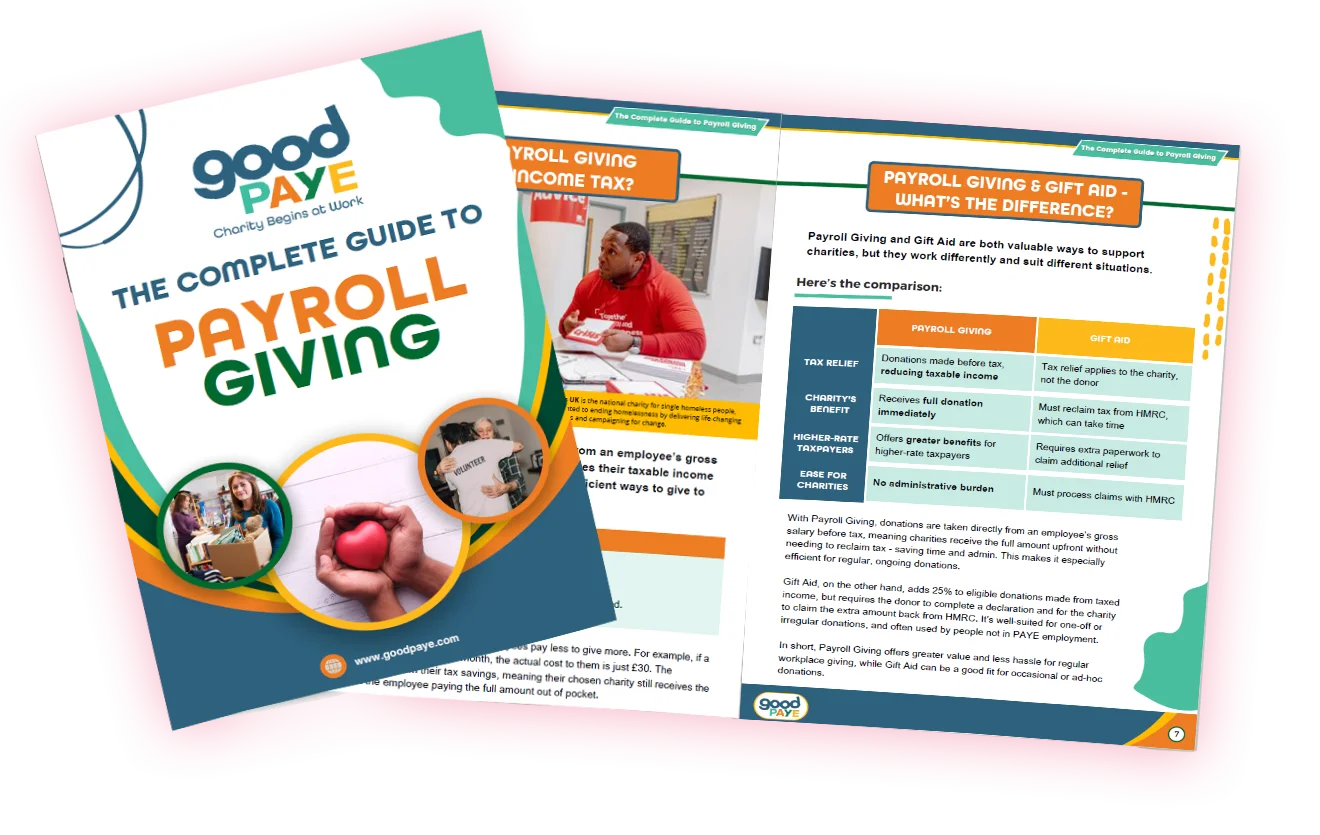After filling in the form, we'll give you a whistle stop tour of our platform, showing you how easy Payroll Giving is to get set up.
Payroll Giving Explained: Everything employers need to know >>

Charitable Donations Tax Relief: How Giving Generously Can Cut Your Tax Bill
Alice Wright, GoodPAYE
When giving something back to charity, most people do it because it feels good, not because they’re secretly plotting to outsmart HMRC! But that doesn’t mean you can’t benefit whilst doing good things… as charitable giving can reduce your tax bill.
Yes, really! With a few smart moves, you can GIVE MORE to the causes you love and PAY LESS to the taxman.
That’s what we call a win-win.
Let’s break down how tax relief works on charitable donations, how you can claim a charitable donation tax deduction, and why Payroll Giving might just be the most generous tax-saving trick you haven’t heard of.
How you can benefit from Tax relief on charitable donations
Charitable donations tax relief means that if you donate to a registered UK charity, you may be able to reduce your taxable income.
There are different ways to give, and the tax relief you can claim depends on how you give.
The most common donation methods are Gift Aid and Payroll Giving.
Both unlock tax benefits, but in different ways…
Help your employees save on tax whilst giving to charity through Payroll Giving
Download your free guide guide here
Everything employers need to know about running a payroll donation scheme.

Gift Aid turns £1 into £1.25
Gift Aid is the most well-known form of charity donation tax deduction in the UK.
When you tick that Gift Aid box, you’re allowing the charity to claim back the basic rate of tax on your donation – an extra 25p for every £1 you give. So, your £20 donation becomes £25 at no extra cost to you. And if you’re a higher or additional rate taxpayer, you can claim back the difference through your Self Assessment, adding an extra charitable donation tax deduction to your return.
It’s simple, effective, and perfect if you’re giving here and there rather than making regular donations. Whether it’s a sponsored run, a monthly standing order, or dropping a few pounds into a collection online, Gift Aid can be added to almost any donation, so long as you’re a UK taxpayer and the charity is registered.
💡 Want to dive deeper? Here’s our full explainer on Gift Aid vs Payroll Giving
But there’s a catch: you have to do the claiming.
That means keeping track, filling in your tax return and being organised enough to remember you made the donation in the first place.
For occasional givers, it’s a small price to pay for the tax benefits of charitable donations. But for regular giving? There’s a better way…

Payroll Giving: Give even more, pay even less
If you’re employed and pay tax through PAYE, Payroll Giving is hands down the simplest and most efficient way to donate to charity.
It’s a simple way to give directly from your salary before tax is deducted. That means you pay less tax, and the charity gets more money than with Gift Aid. Making it a smarter solution for regular donors.
Let’s say you donate £10 through Payroll Giving. If you’re a basic rate taxpayer, it only costs you £8. If you’re on the higher rate, it costs just £6. And there’s no faffing about with forms or Self Assessment – it all happens automatically via your payroll.
It’s the unsung hero of charitable giving tax deduction. It’s particularly brilliant for higher earners who want to maximise the tax benefits of charitable donations without the admin headache. And unlike Gift Aid, which makes the charity wait to reclaim the tax, Payroll Giving sends the full tax-free amount to the charity right away. That means they get more, faster—and with complete certainty.
🧾 You’ll find more detail here: HMRC Payroll Giving guide

Gift Aid or Payroll Giving – which is better?
It’s the big question when it comes to tax-efficient generosity: Gift Aid or Payroll Giving – which one actually gives more bang for your charitable buck?
The honest answer is both are brilliant in their own right. It just depends on how (and how often) you give.
Do other types of giving qualify for tax relief?
They do, though these options tend to fly a little under the radar.
While Gift Aid and Payroll Giving are the most popular (and practical) ways to unlock charitable donations tax relief, they’re not the only tools in the tax-saving toolbox.
For those in a position to make larger or less conventional donations, there are additional ways to claim a charitable tax deduction, and they can be surprisingly generous when it comes to tax efficiency.

1. Donating shares, land or property
If you’re lucky enough to own assets like shares, land or property, you can donate them directly to a UK-registered charity and receive full charity tax deduction benefits.
This means:
- You won’t pay any Capital Gains Tax on the increase in value of the asset
- You can deduct the full market value of the donation from your income when calculating your Income Tax
It’s a highly tax-efficient form of charitable giving, particularly if you’re looking to make a sizeable one-off donation while reducing your overall tax liability.
That said, it does require proper valuation, paperwork and usually a chat with a tax adviser to make sure everything’s done correctly.

2. Leaving a donation in your will
Another lesser-known but valuable form of charitable giving tax deduction involves making a gift to charity in your will. Not only can this help the causes you care about beyond your lifetime, but it can also reduce the amount of Inheritance Tax your estate has to pay.
Currently, if you leave at least 10% of your net estate to charity, your Inheritance Tax rate drops from 40% to 36% on the rest. It’s a thoughtful way to pass on your values – and your assets – with a tax benefit attached.
While these options aren’t as common, they’re powerful tools for those considering larger-scale generosity. If you’re planning to donate land, shares or include a charity in your will, it’s wise to speak with a financial adviser or solicitor to ensure you make the most of the tax benefits of charitable donations.
After all, when it comes to giving, a little planning goes a long way… and it’s always nice when your legacy (or your shares) can do good and lower your tax bill.
Generosity pays
Most people don’t give to charity because they’re chasing tax breaks. They do it because they care. Because they want to make a difference. Because helping others feels good.
But if doing good can also help you save a little money too, then everyone’s a winner!
Whether you’re already donating or just thinking about starting, it’s well worth digging deeper into how you can maximise the tax benefits of charitable donations. A few small tweaks in how you give could make your money go further, without costing you a penny more.
For example, if you’ve been setting up regular donations from your bank account, switching to Payroll Giving could allow you to give more to your chosen charities while actually paying less. That’s because your donations are taken from your gross pay—before tax—so you get an instant charity tax deduction with zero admin. It’s seamless, tax-smart, and more impactful for the causes you support.
Or maybe you’ve been adding Gift Aid to one-off donations (gold star if so!).
But did you know that if you’re a higher-rate taxpayer, you could also claim back extra through your Self Assessment? This little-known charitable tax deduction can help you keep more of your money while still boosting the charity’s income by 25%.
And let’s not forget: there are other forms of charitable giving – like donating land, shares, or even leaving a legacy in your will – that offer generous tax advantages. They’re less everyday, sure, but if you’re making big plans or thinking long-term, they’re absolutely worth exploring.
This is about making sure your generosity works as hard as you do.
Why give £10 when you could give £12.50, without spending a penny more?
Why miss out on a charitable giving tax deduction when it’s sitting right there waiting to be claimed?
So, if you’re already giving, brilliant. Just make sure you’re giving in the smartest way possible. And if you haven’t started yet, there’s no time like the present to begin your giving journey. You’ll be helping the causes you care about, and if it means paying a little less to the taxman in the process? Well, that’s just a delightful bonus.
Watch on demand:
Payroll Giving Webinar
In this short webinar, we cover:
The impact Payroll Giving has
How employers can make a difference
What you can do to drive social change



